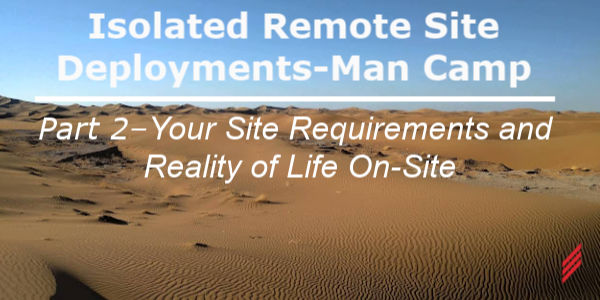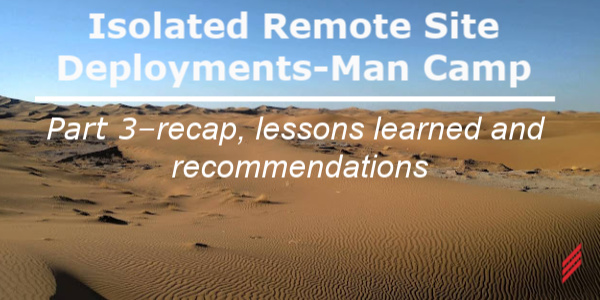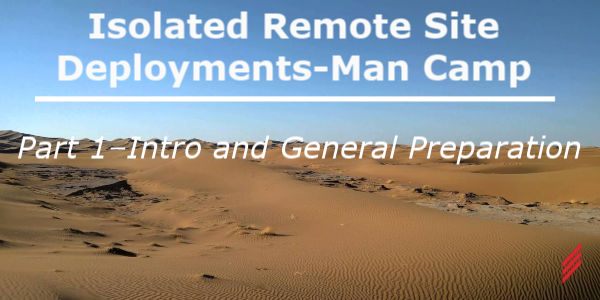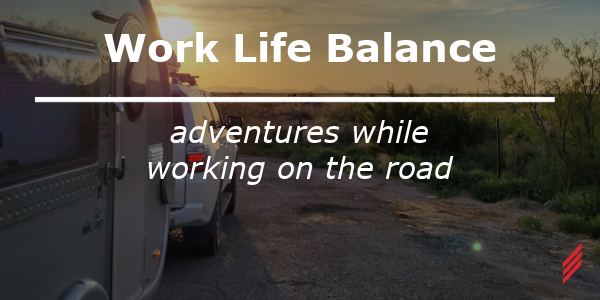Isolated Remote Site Deployments-Man Camp Part 2–Your Site Requirements and Reality of Life On-Site
by Ray Racine on Mar 7, 2019 10:30:00 AM

In Part 1, I discussed How to Bid and How to Prepare for deployment to a generic remote site. Part 2 covers some site specifics that will be important for your expectations and success.
So, now that we have covered some of the more generic stuff, you need to consider the site. Make certain that you have a site contact. THIS IS REALLY IMPORTANT! You need to find out what the site requirements & conditions are. Some of this is common sense; some of it not so much. Despite the fact that most of these camps have occasional service calls from vendor reps, not all of them are very organized about giving you what you need to know about the site. You will probably have to advocate for yourself. Be insistent and thorough.
- PPE – What are the requirements? Do they provide it or do you need to pack it? A hard hat & steel toe boots take more luggage space than you think. What does the site require – what do you have to bring?
- Tools – Do they have them or do you need to provide. I’d hate to have to lug a 36” pipe wrench around the airport.
- If possible, try to ship them out ahead of time.
- Your equipment might be SAE. The site might be all metric – find out.
- Clothing – Who knew they would require programmers to wear long sleeves in the Sahara Desert? A buddy of mine had to cut the toes out of his socks and wear them as sleeves. It pays to know what to pack.

- Pack Smart – Probably not a good time to practice your minimalist skills. More might be better.
- Laundry – is there a way to do it on site? That might affect how much you pack.
- Medical Care – If you have serious and chronic conditions, you may find that the paramedic in the site health center is not enough for you and the 2 hours to a second world hospital may not cut it either. Oh yeah & there probably isn’t a medivac. Find out what the site provides.
- Critters - We had small deadly snakes and spiders with 8-10 inch leg spans. Not a lot of them; but handy to know they are around. You might want to find out what wildlife you may encounter.
- Food – Where and when do you eat? In my case it was a big mess hall buffet with fixed hours for the three meals. No food court with options. Hope you like what’s on the menu.
- If you have dietary restrictions, you may be out of luck. The kitchen may not accommodate your needs. Can you pack in a month’s worth of food?
- Phone – Yours might not work there at all, or at least not without pre-arranging for special plans or upgrades. Check it out before you get there. We get kind of accustomed to assuming that they just work – not always true.
- Internet – What kind / quality of access? On my site, connectivity was poor and the wireless was jammed with over 1000 users and not enough band width. You may need to stay up really late to get reliable service, or maybe you can get a wired connection. Might be a good idea to put your manuals & reference materials on your hard drive.
- When you get there – At the site I was working with, they kind of dropped you off at the gate without much for instruction. Try to get your site contact to meet you or set you up with someone to meet you and get you settled.
- Language – You might not be in Kansas anymore. Many sites do have English speakers in abundance; but if not, you may require a translator to do your work with the local crew. Find out how the site handles it.

- Site Transportation – This can be tough. You probably won’t be able to rent a car in your man camp. Ideally try to arrange with your site contact to have a driver who takes you to and from your work site (someone who also works in that area). My site was miles across, had no map or bus schedule posted and not all of the drivers had English under their belt. You can spend a lot of time just standing around.
- My bunk – Where do you sleep? It might be open dorm style. I got to sleep in half of a converted shipping container. It might matter to you. Find out first.
- There is no “there” to go to – you won’t get a break in the evening or on the weekend, and you will probably work 7 long days a week. Consider loading up an external hard drive with movies or books or other distractions. Odds are good that they don’t have pay-per-view.
- Money – The greenback might rule here; but it might just be paper there. In my case it hardly mattered, except in the travel phase. On the site, there was a very limited commissary where you could find toothpaste and snacks, and the watering hole that did take US dollars. In cases where you will have to spend money:
- Get an international Travel Credit Card with no transaction fees. It can save you a ton of money.
- Get local currency before you travel if possible. Your own bank will be much more gentle than the currency kiosk at the Airport. If you try to pass US dollars with merchants, they will likely rip you off with the rate they give.
Sounds like a blast, doesn’t it? In addition to above, my last foray included four planes, three buses, three layovers, 53 hours of door to door travel on my return. Yours might be worse. I strongly recommend a water bottle and wet naps in your carry-on luggage. It might not be a shower; but a few wet naps and a couple of minutes in the rest room can help you to feel a little more human in your travels. And buying a bunch of $6 bottles of water in the airport just makes me nuts. Lots of airports have the bottle refill fountains.
About the author
Ray has retired from Hallam-ICS, but his contributions to the company continue to be valued.
Read My Hallam Story
About Hallam-ICS
Hallam-ICS is an engineering and automation company that designs MEP systems for facilities and plants, engineers control and automation solutions, and ensures safety and regulatory compliance through arc flash studies, commissioning, and validation. Our offices are located in Massachusetts, Connecticut, New York, Vermont and North Carolina and our projects take us world-wide.
You May Also Like
These Related Stories

Isolated Remote Site Deployments - Man Camp Part 3 – Recap, Lessons Learned and Recommendations

Isolated Remote Site Deployments-Man Camp Part 1–Intro and General Preparation



No Comments Yet
Let us know what you think